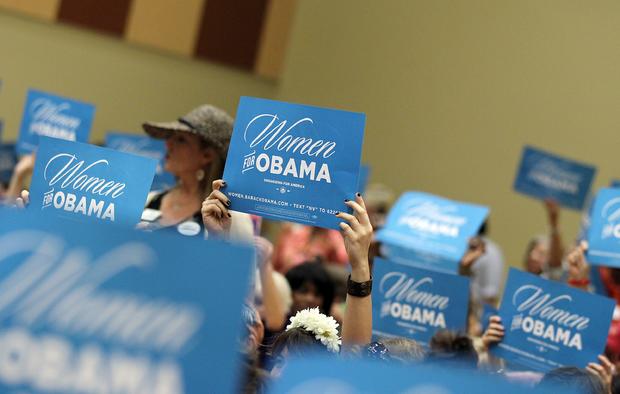What's behind Obama's big lead among women?
(CBS News) President Obama's lead in the critical swing states of Ohio and Florida, as reflected in a new Quinnipiac University/CBS News/New York Times poll, can be attributed in large part to a huge advantage among women voters.
Democrats traditionally have an advantage with women voters. But Mr. Obama's advantage among women has grown to striking proportions. The president is also now even winning married women voters in the two states -- a group that previously backed Mitt Romney.
Romney, meanwhile, has an advantage among men in both swing states. But it's not wide enough to make up for his lack of female support. CBS News director of surveys Sarah Dutton said the data doesn't point to any one clear explanation for the widening of the gender gap.
"Women are much more likely to think Barack Obama cares about them than Romney does, and they think Barack Obama would do a better job than Mitt Romney on women's reproductive health issues, by two to one," Dutton said. "It's difficult to isolate just one reason for the increase in support among women."
Over the past month, the gender gap has helped Mr. Obama gain a 10-point lead in Ohio, according to the latest Quinnipiac University/CBS News/New York Times poll, as well as a nine-point lead in Florida and a 12-point lead in Pennsylvania. After the latest round of surveys, CBS News no longer considers Pennsylvania a battleground state. Ohio is still considered in play (though it now leans toward Mr. Obama) while Florida is considered a tossup.
In Ohio, women prefer Mr. Obama over Romney by a margin of 25 points, 60 percent to 35 percent. (Watch CBS News correspondent Nancy Cordes' report at left. ) In August, Mr. Obama's advantage among Ohio women was just 13 points. Ohio men, meanwhile, prefer Romney over Mr. Obama by a margin of eight points, 52 percent to 44 percent. In August, Romney held a two-point lead among Ohio men.
In Florida, women voters prefer Mr. Obama by 19 points, 58 percent to Romney's 39 percent. In August, the president's lead among Florida women was 12 points. Male voters in Florida prefer Romney, 50 percent to 47 percent. Romney's advantage among Florida men has diminished slightly since August, when he had a six-point lead.
It's impossible to predict what the gender gap in these states will ultimately look like on Election Day. In 2008, Mr. Obama won the support of both men and women in Ohio and Florida, though the gap was narrower among men. Nationally, Mr. Obama won the female vote 56 percent to 43 percent in 2008.
In 2004, Democrat John Kerry carried the female vote nationally, 51 percent to 48 percent, though he lost the election to George W. Bush.
Growing support among married women
Last month, the race was effectively even among married women in Ohio (with 48 percent backing Romney and 47 percent backing Mr. Obama). Now, 50 percent of married women voters in Ohio back Mr. Obama, while 46 percent support Romney.
In Florida last month, married women backed Romney 49 percent to Mr. Obama's 44 percent. Now, married women voters in Florida support Mr. Obama over Romney, 52 percent to 46 percent.
Democrats have traditionally held an advantage among single women, but not married women. In a CBS News/New York Times national poll released earlier this month, Romney led among married women (50 percent to Mr. Obama's 44 percent), while Obama won the support of single women 65 percent to 30 percent.
Dutton explained that single women are more likely than married women to be younger, have lower incomes, and to be African American or Latino -- all groups that favor the president. They are slightly more likely than married women to identify themselves as Democrats.
Explaining the gender gap
While there are several factors that have contributed to the gender gap, it's worth noting the latest poll was conducted Sept. 18-24. That means it began one day after a video surfaced showing Romney telling supporters that there are 47 percent of voters who are "dependent on government" and will back Mr. Obama "no matter what."
Grant Neeley, a political science professor at the University of Dayton, said the increase in the gender gap "probably reflects on perhaps that statement as being seen as a callous statement."
"It's very likely in the wake of that statement that people, women in particular, are maybe wanting a more compassionate candidate," he told CBSNews.com. "I'd anticipate that the gap will probably tighten back up as we move away from that comment."
It's also noteworthy that both campaigns have made express efforts to reach out to women voters. Actress Natalie Portman and former Ohio First Lady Frances Strickland spoke at an Obama campaign event for women on Sept. 19 in Cincinnati, while "Women for Mitt" launched a "Stronger Middle Class" bus tour of South Florida on Sept. 17.
The Obama campaign has made concerted efforts to specifically address women's issues. A review of campaign ads run on broadcast and national cable from April 25 to Sept. 8 shows that 12.5 percent of pro-Obama ads were focused on women's health, according to the Wesleyan Media Project. On top of that, another 9.5 percent focused specifically on abortion.
The data had no specific breakdown for pro-Romney ads focused on women, though the Romney campaign has run ads that specifically target women. Earlier this week the campaign released an ad called "dear daughter" that points to female unemployment and poverty rates to argue "Obama's policies are making it harder on women."

